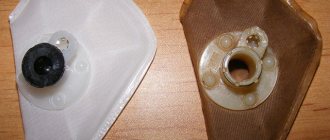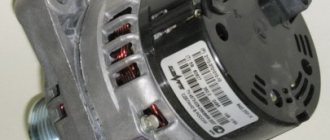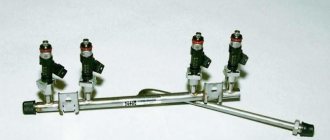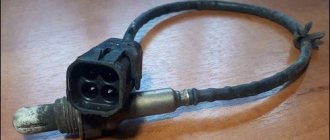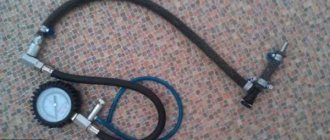The efficient operation of the injection engine is ensured by a set of sensors. They all connect to the ECU. Lada hatchbacks of the 2112 family were produced only with injection engines, and two varieties of these internal combustion engines are 16-valve. We will talk about them further. All VAZ-2112 sensors, their location and appearance will be shown in the photo.
The excess oil pressure sensor, which is not connected to the ECU, is shown in the video.
Injection system
Nowadays, cars have become more advanced and technologically advanced. The control process from a carburetor engine switched to an injection engine. A car engine injector is much more reliable than a carburetor.
The injection system will allow you to more correctly control the car engine, which allows you to use fuel more economically. Modern cars are equipped only with injection engines, since using a carburetor engine is not advisable.
The injection system uses a large number of different sensors that send signals to the electronic engine control unit. Since the injection system uses a large number of sensors, they often fail. This is due to aging or improper operation of the car.
In this article we will talk about all the sensors installed on Lada cars, what role they play and what they are needed for.
Standard adsorber for Priora - article number, device, price and location
The breather of the Priora car absorber is located on the top left relative to the engine cover. Replacing the absorber valve is not difficult, given that the instructions and steps are simple. Finding it is quite easy: the breather hose goes to the throttle to direct fuel in the desired direction.
Gasoline consumption will depend on the quality of its operation - the efficiency of the power system will decrease, since part of the engine vapor will be released into the atmosphere, as was the case in old cars. The VAZ-2170 catalog implies the presence of the following components in the “Gasoline Vapor Recovery System”:
- Breather (adsorber valve) - 2170-01164042-00, price - about 800 rubles.
- Hose 115 cm long - 2170-01164087-20, price - about 500 rubles.
- Hose 70 cm long - 2108-31164103-10, cost - 350 rubles.
- Hose 90 cm long - 2110-31164109-12, cost - 400 rubles.
- Hose 25 cm long - 2110-31164105-12, cost - 150 rubles.
- Steam removal tube – 2170-01164084-01 – 150 rub.
- Front steam exhaust pipe – 2170-01164244-01 – 200 rub.
- Tube – 2170-01164282-00 – 300 rub.
- Adsorber – 2170-01164010-00 – 800 rub.
- Separator – 2170-01164005-01 – 1500 rub.
- Middle steam outlet tube - 2170-01164248-00 - 300 rubles.
Mass air flow sensor
The mass air flow sensor, also known as mass air flow sensor, is installed on all fuel-injected Lada and VAZ cars. The sensor is located between the intake receiver bellows and the air filter box. This sensor is involved in the process of forming the fuel-air mixture. It also estimates the amount of intake air, taking into account its temperature. If there is a malfunction, the “CheckEngine” light does not always light up.
Signs of sensor malfunction:
- Loss of vehicle dynamics;
- Unstable idle;
- Jerking when moving;
- Difficulty starting the engine;
- High fuel consumption;
Speed sensor
The speed sensor is installed on the gearbox housing and is designed to measure the speed of the vehicle and calculate the kilometers traveled. The speed sensor also provides readings for preparing the air-fuel mixture while the car is moving. You can notice that when the car is rolling at neutral speed, the idle speed is slightly higher than when the car is stationary. When there is a malfunction, the “CheckEngine” light almost always comes on.
Signs of sensor malfunction:
- There are no increased speeds when driving at neutral speed;
- Speedometer does not show speed;
- The odometer does not work;
- EUR does not work;
Causes of terminal oxidation
As a rule, there are 2 main reasons:
1. Leakage of filled electrolyte is perhaps the most common problem. The electrolyte is an acid, which, when it hits the surface of the terminal, enters into a chemical reaction with it, as a result of which oxidation begins.
As a rule, such problems are not typical for new batteries. After all, these are closed-type batteries in which the electrolyte is in a sealed container, where it evaporates and precipitates. However, the design of the battery prevents it from entering the environment.
However, as the battery wears out, its casing cracks and electrolyte in the form of steam begins to escape into these microcracks. So it settles directly on the terminal, as a result of which a reaction begins. The car owner should consider such a phenomenon as a sign of malfunction and wear of the battery.
If the battery terminal is not fully tightened, this may cause oxidation.
2. Tightening of the terminal - such situations arise from time to time. This means that car owners simply place the terminal on the electrode, and then immediately get behind the wheel without tightening it with bolts. Insufficient quality of fixation leads to poor contact and oxidation on the electrode and terminal. In this case, it is enough to remove the terminal, thoroughly clean both it and the electrode, then put it on and tighten it thoroughly. Just not with all your strength, otherwise you can tear off the fasteners.
In this case, it is necessary to use 2 wrenches at once, tightening the nut with one of them, and holding the bolt with the other. But it is not recommended to pull with all your might on one side, because this can lead to deformation of the plastic. You should also be wary of another common problem - the gradual loosening of the pin seals. This occurs as a result of poor quality removal of clamps from wires. Therefore, it is necessary to accurately dose the force.
Consequences of oxidation
They manifest themselves in a noticeable deterioration of the stain and quality of contact. As a result, the battery is not able to charge and work properly. Subsequently, this will lead to serious discharge of the battery, which has an extremely negative effect on it. In addition, this is reflected in the difficulty of starting the power unit, or even in the absence of a response to turning the key.
Coolant temperature sensor
Coolant temperature sensor, also known as DTOZH. Installed in the thermostat housing. Serves to prepare the air-fuel mixture when starting the engine. It also simultaneously displays coolant temperature readings on the car’s dashboard and turns on the engine cooling fan. If there is a malfunction, the “CheckEngine” light does not light up.
Signs of sensor malfunction:
- Loss of vehicle dynamics;
- Unstable idle;
- Jerking when moving;
- Difficulty starting the engine;
- High fuel consumption;
- Difficulty starting in the cold season;
Crankshaft position sensor
Crankshaft position sensor, also known as DPKV. Installed on a bracket near the generator belt drive pulley. Works on the law of electromagnetic induction. Reads readings from the crown of the generator drive pulley. Sets the ignition timing angle (IAF). If there is a malfunction, the “CheckEngine” light comes on.
Signs of malfunction:
- The engine runs intermittently;
- The engine does not start (no spark);
How to repair the adsorber and valve
Often the nature of damage to these parts is very large, since they operate under high wear conditions. The valve really shouldn't be repaired because the part is so small. But the main device often breaks down because the foam rots inside it. Coal breaks through the tubes and clogs the solenoid valve.
To repair, you will need to replace the foam separator. To do this, you will need to remove part of the gasoline vapor recovery system:
- Open the hood, stand on the left. Stretch your hand slightly down where the gasoline vapor recovery system is located (on the left edge).
- Clamp the two clamps that hold the separator outlet tubes. Remove the fitting tips.
- Using a “10” wrench, unscrew the bolts securing the radiator.
- Pull the adsorber towards you.
Phase sensor
The phase sensor is installed on an engine with 16 valves, located near the fuel rail. Based on the law of electromagnetic induction, it takes readings from the intake camshaft master pulley. Participates in the process of formation of the air-fuel mixture for each cylinder separately. In the event of a malfunction, the engine begins to operate in emergency mode. When there is a malfunction, the “CheckEngine” light almost always comes on.
Signs of malfunction:
- The engine runs intermittently;
- Increased fuel consumption;
- Unstable engine operation at idle;
Idle speed control
The idle speed regulator, also known as IAC, is installed in the throttle valve. Designed to regulate idle speed on engines without the E-GAS system. The sensor is quite unreliable and fails very often. It is a motor with a worm gear. If there is a malfunction, the “CheckEngine” light does not light up.
Signs of malfunction:
- Not smooth idle;
- The revolutions are floating;
- Troubles the engine;
Self-check functionality
In most cases, when problems arise with the TPS, the “check engine” error is displayed. By connecting a diagnostic device, you can identify its code and causes of the error. It happens that for some reason the “check” does not light up, in which case you cannot do without using a multimeter for diagnostics.
The first step is to make sure that power is supplied to the sensor itself. To do this, you need to disconnect the chip with wires from the device and measure the contacts with the ignition on. If power is supplied, then the device itself is inspected.
Visual inspection of the sensor. In this case, we are talking about checking the internal components of the product. Most often, the slider loses contact with the resistive layer.
As mentioned above, if the causes of malfunctions in the sensor are identified, it must be replaced.
Throttle Position Sensor
The throttle position sensor (TPS) is installed on the throttle valve on cars without the E-GAZ system. Designed to regulate engine speed. The sensor is not reliable and often fails. If there is a malfunction, the “CheckEngine” light does not always light up.
Signs of malfunction:
- Not smooth idle;
- The revolutions are floating;
- Troubles the engine;
- When starting the engine, the speed is increased;
- Spontaneous increase or decrease in speed;
Oil pressure sensor
The oil pressure sensor is installed in the cylinder head. Designed to indicate oil pressure and indicate oil pressure when the engine is running. A very reliable sensor that rarely fails. The “CheckEngine” light does not light up when there is a malfunction.
Signs of malfunction:
- The oil pressure light is constantly on;
- The oil pressure light does not light up when the ignition is turned on;
Oxygen sensor
The oxygen sensor is installed in the exhaust manifold of the car. Serves to monitor exhaust gases and adjust the air-fuel mixture. A reliable sensor rarely fails. If there is a malfunction, the “CheckEngine” light does not always light up.
Signs of sensor malfunction:
- Loss of vehicle dynamics;
- Unstable idle;
- Jerking when moving;
- Difficulty starting the engine;
- High fuel consumption;
- Black smoke when driving at high speeds;
What does it consist of?
Oxygen sensors for Lada Priora consist of:
- metal case;
- four-pin connector for connecting electrical wiring:
- external electrode (platinum);
- internal electrode (zirconium);
- electrode insulator (ceramics);
- sensor electric heater;
- protective casing of the external electrode.
The lambda probe elements are resistant to high temperatures, as well as to its constant changes. This is due to the fact that its installation location is the engine exhaust system, some areas of which heat up to 900 °C.
Knock sensor
The knock sensor is installed on the cylinder block under the intake receiver. Based on the principle of the piezo element. Engine detonation is measured and the air-fuel mixture is adjusted. Quite a reliable sensor. If there is a malfunction, “CheckEngine” does not light up.
Signs of sensor malfunction:
- Loss of vehicle dynamics;
- Unstable idle;
- Jerking when moving;
Air conditioner sensor
The air conditioning sensor is installed under the bumper next to the air temperature sensor. Designed to turn on the air conditioner or protect against turning on at low temperatures. Let us remind you that the air conditioning in Lada cars only works at outside air temperatures of +5 degrees. Reliable sensor, no breakdowns were detected.
Signs of malfunction:
- The air conditioner clutch does not engage;
Mechanical engineering keeps up with the times, so new sensors appear quite quickly in car engine control.
Where to buy car accessories
Spare parts and other products for the car are easily available for purchase at auto stores in your city. But there is another option that has recently received significant improvements. You no longer need to wait a long time for a parcel from China: the AliExpress online store now offers the opportunity to ship from transshipment warehouses located in various countries. For example, when ordering, you can specify the “Delivery from the Russian Federation” option.
Follow the links and choose:
| Jansite Tire Pressure Monitoring System, Solar Powered TPMS with Digital LCD Display | Eunavi s car alarm system, central kit with remote control | Car radar detector YASOKRO V7, 360 degrees |
| Radar detector Karadar STR G820 Led 2 in 1, radar detector with GPS | Auto radar detector 12V | Radar detector Ruccess STR S900 |




